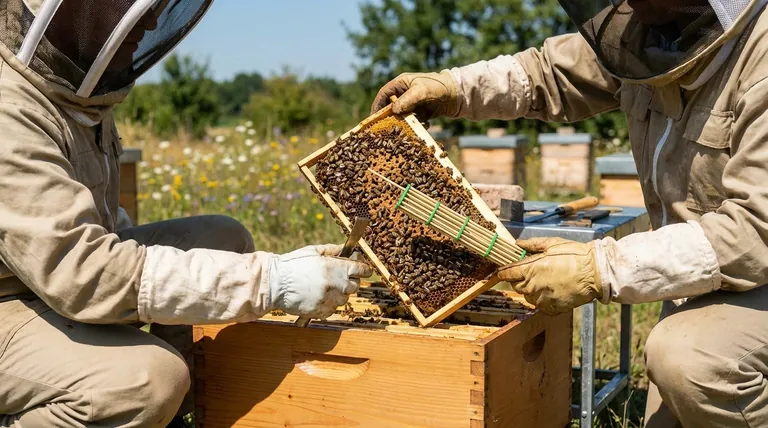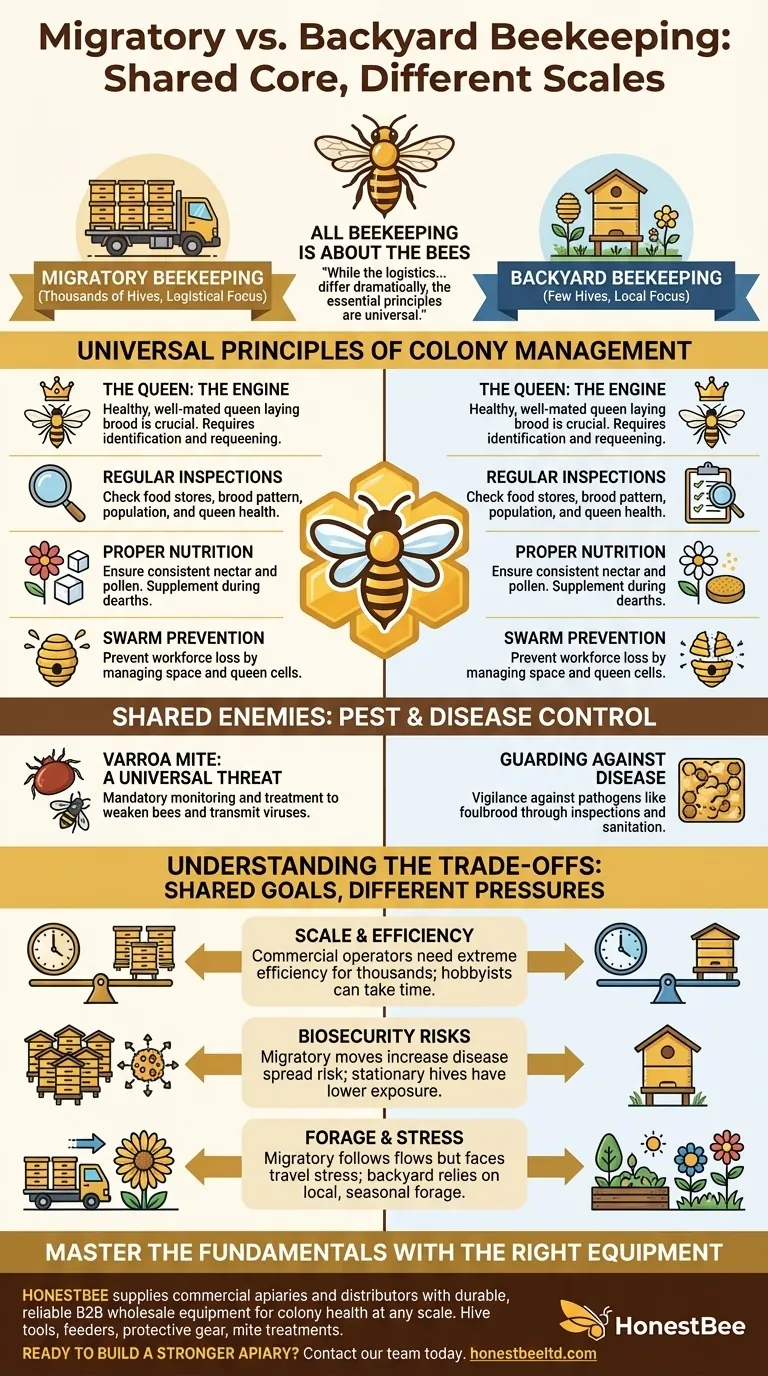At their core, all beekeeping is about the bees. While the scale and lifestyle of migratory and backyard beekeeping are worlds apart, the fundamental work is remarkably similar. Both practices demand regular, hands-on management to ensure colonies are healthy, well-fed, and productive. The biological needs of the honey bees themselves create a shared foundation of required tasks for any beekeeper, regardless of their operation's size.
While the logistics of moving thousands of hives versus tending to a few in a garden differ dramatically, the essential principles are universal. The bees' non-negotiable needs for health, nutrition, and a productive queen dictate the core responsibilities of every beekeeper.

The Universal Principles of Colony Management
The day-to-day and season-to-season work inside the hive is governed by bee biology, not by the hive's location. This creates a significant overlap in essential skills and knowledge.
The Central Role of the Queen
For both migratory and backyard beekeepers, the queen is the engine of the colony. A healthy, well-mated queen laying a solid brood pattern is the primary indicator of a hive's viability.
All beekeepers must learn to identify a failing queen, requeen a colony when necessary, and manage the hive to support her productivity.
Regular Hive Inspections
The practice of "working a hive" involves the same checklist for everyone. Beekeepers of all types must regularly inspect their colonies for the same key indicators.
This includes checking food stores (honey and pollen), evaluating the brood pattern for signs of disease, assessing the colony's population and temperament, and looking for the presence of the queen or fresh eggs.
Ensuring Proper Nutrition
Bees require a consistent supply of nectar (carbohydrates) and pollen (protein). While a backyard beekeeper relies on local, seasonal forage, a migratory beekeeper moves hives to follow massive nectar flows.
However, both must be prepared to supplement their bees' diets. Feeding sugar syrup during a nectar dearth or providing pollen patties to stimulate brood rearing are standard practices across the board.
Swarm Prevention and Management
A hive that swarms is a hive that has lost up to 60% of its workforce and its old queen. This represents a significant loss of productivity and honey potential, which is a problem for any beekeeper.
The techniques used to prevent swarming—such as ensuring the colony has enough space, splitting strong hives, and managing queen cells—are fundamental skills for all.
Shared Enemies: Pest and Disease Control
Threats to honey bee health do not distinguish between stationary and mobile hives. The fight against pests and diseases is a universal and constant battle.
The Varroa Mite: A Universal Threat
The Varroa destructor mite is the single greatest threat to honey bee colonies worldwide. It weakens bees by feeding on them and transmits deadly viruses.
All responsible beekeepers, commercial or hobbyist, must have a Varroa management plan. This includes monitoring mite levels and applying appropriate treatments to keep populations under control. The methods are the same; only the scale differs.
Guarding Against Disease
Pathogens like American Foulbrood (AFB), European Foulbrood (EFB), and chalkbrood can devastate a colony.
Vigilance is the key defense. Both migratory and backyard beekeepers must learn to recognize the symptoms of these diseases through regular inspections and practice good hive sanitation to prevent their spread.
Understanding the Trade-offs: Shared Goals, Different Pressures
While the core tasks are similar, the context and pressures are not. Understanding these differences highlights why mastering the fundamentals is so critical.
Scale and Efficiency
A backyard beekeeper can afford to spend an hour on a single hive. A migratory beekeeper with 2,000 hives must perform the same essential checks in just a few minutes per colony.
The commercial operator must execute the same fundamental tasks with extreme efficiency and logistical precision to remain profitable.
Biosecurity Risks
Disease management is a shared duty, but the risk profile is different. Migratory beekeeping concentrates thousands of hives from various regions into one area, such as an almond orchard.
This creates a much higher potential for the rapid spread of pests and diseases between operations, making vigilant health monitoring even more critical for commercial beekeepers.
Forage and Stress
A stationary hive adapts to the local seasonal flow of nectar. Migratory hives are moved to specific, massive nectar flows but can experience periods of nutritional stress and travel-related disruption between pollination contracts.
This means both types of beekeepers manage nutrition, but migratory beekeepers must do so within a complex logistical framework.
Making the Right Choice for Your Goal
The similarities reveal that the foundation of all beekeeping is the same. How you apply this knowledge depends entirely on your objective.
- If your primary focus is hobby beekeeping: Master these core principles of colony health, nutrition, and pest management. They are the complete foundation you need for success.
- If your primary focus is exploring commercial beekeeping: Recognize that success depends on your ability to execute these fundamental tasks with near-perfect efficiency and consistency at a massive scale.
Understanding these shared fundamentals reveals that successful beekeeping is ultimately about mastering the universal needs of the honey bee colony.
Summary Table:
| Shared Beekeeping Principle | Applies to Migratory Beekeeping | Applies to Backyard Beekeeping |
|---|---|---|
| Queen Management | Essential for colony productivity and health. | Essential for colony health and sustainability. |
| Regular Hive Inspections | Performed for health, disease, and food checks. | Performed for health, disease, and food checks. |
| Nutrition Management | Supplementing diet during dearths or travel. | Supplementing diet during seasonal dearths. |
| Swarm Prevention | Critical to prevent loss of workforce and honey. | Critical to maintain colony stability. |
| Varroa Mite Control | A mandatory, non-negotiable management practice. | A mandatory, non-negotiable management practice. |
Master the Fundamentals with the Right Equipment
Whether you're managing two hives or two thousand, the principles of successful beekeeping are the same. The right equipment is fundamental to applying these principles effectively and efficiently.
HONESTBEE supplies commercial apiaries and beekeeping equipment distributors with the durable, reliable supplies needed to master colony health at any scale. From hive tools and feeders to protective gear and mite treatments, our wholesale-focused operations ensure you get the quality equipment your operation depends on.
Ready to build a stronger, healthier apiary? Contact our team today to discuss your wholesale supply needs.
Visual Guide

Related Products
- Professional Bamboo Queen Isolation Cage
- Professional Plastic Queen Excluder for Modern Beekeeping
- Langstroth Screen Bottom Board for Beekeeping Wholesale
- Black Plastic Beetle Barn Hive Beetle Trap for Beehives
- Metal Queen Bee Excluder for Beekeeping
People Also Ask
- Are queen cages reusable? Yes, with proper cleaning for sustainable beekeeping.
- What are the components of a standard queen cage? A Guide to Safe Queen Introduction
- What is sequestration, and how does it help bees reorient? A Safer Guide to Hive Relocation
- Where should the queen bee's cage be placed in the hive? Maximize Acceptance in the Brood Nest
- What is the role of the queen cage in beekeeping? A Key Tool for Successful Queen Introduction



















